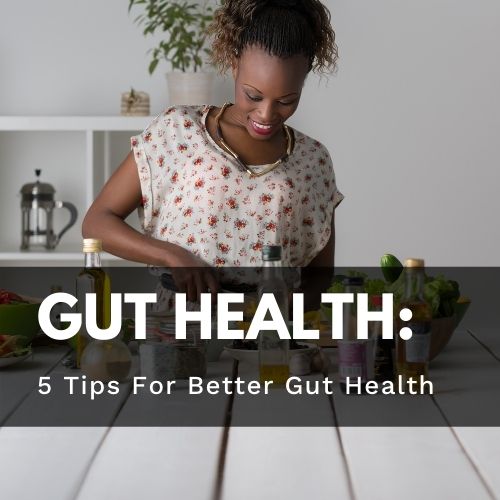Your Cart is Empty
COLLECTIONS:
SPECIAL OFFERS:
LEARN:

Low Histamine Diet 101
August 12, 2021 5 min read
If you’re relying on antihistamines to treat allergy symptoms, you may want to consider another approach.
Although these medications may seem effective, they don’t address the root cause of symptoms and can create negative side effects.
If you’re experiencing symptoms such as nasal congestion, sinus issues, headaches, or hives; you may want to look at the foods you’re eating each day. Particularly foods high in histamine.
This article will talk about what histamine is, symptoms of a histamine intolerance, what foods to eat and which ones to avoid, a sample meal plan, tips for following a low histamine diet, as well as some possible beneficial supplements to consider as well.

What is Histamine?
Histamine is a chemical that is found naturally in all cells in our body. It plays a role in several bodily systems including the immune, neurological, and digestive systems.
Not only does our body make histamine, it’s also found in certain foods in varying degrees.
Those with a condition called histamine intolerance, may experience allergy-like symptoms when they consume high histamine foods due to their body not being able to break down the histamine as effectively.
Histamine intolerance is generally caused by a defect in one of two enzyme systems that break down histamine: N-methyl transferase (HMT) and diamine oxidase (DAO); with DAO being the most probable cause of the intolerance (1).
Additionally, certain medical conditions may impact how well the body is able to break down histamine. Those include (2,3):
- Irritable Bowel Syndrome (IBS)
- Small Intestinal Bacterial Overgrowth (SIBO)
- Gastroesophageal reflux disease (GERD)
- Gut dysbiosis
- Chronic stress
Signs of a Histamine Intolerance:
Signs and symptoms of a histamine intolerance may be different for everyone, but common ones include (4):
- Nasal congestion
- Runny nose
- Sneezing
- Seasonal Allergies
- Itching around the eyes, ears or nose
- Shortness of breath
- Headaches
- Hives
- Fatigue
- Nausea or vomiting
- Digestive issues (especially heartburn)
Keep in mind that a histamine intolerance is often difficult to identify, since symptoms are generally similar to other conditions, and aren’t always immediate.
High Histamine Foods to Avoid:
Now that you know that high-histamine foods may trigger symptoms such as runny nose or itchy eyes, let’s talk about what foods are highest in histamine.
Keep in mind that everyone reacts to foods differently, and some may tolerate high histamine foods better than others. It’s important to try foods out yourself to determine how your body tolerates it.
Foods that have been reported to be higher in histamine include (5):
- Cured or smoked meats such as salami, sausages or deli meats
- Canned fish such as sardines or tuna
- Leftover meat (after meat is cooked, the histamine levels can increase)
- Vegetables such as tomatoes, eggplant, and spinach, as well as fermented vegetables such as sauerkraut, pickles or kimchi
- Fermented dairy products including aged cheeses, yogurt, kefir, buttermilk and sour cream
- Gluten containing grains such as wheat, rye, barley, and spelt
- Dried fruits
- Nuts and seeds including peanuts, walnuts, pistachios and cashews
- Beverages such as alcohol, apple juice, black tea, green tea, energy drinks, and sodas
- Herbs, spices and sauces such as yeast, cinnamon, chili powder, curry powder, cayenne, nutmeg, cloves, anise, and soy sauce
- Artificial food colors and preservatives
In addition, there are several foods that release histamine in the body. Those include:
- Citrus fruits such as oranges, lemon and lime
- Other fruits such as bananas, plantains, strawberries, kiwi, pineapple and papaya
- Cocoa and chocolate
- Beans
- Wheat germ
- Most vinegars (especially balsamic and wine vinegar)
- Food additives such as nitrates, artificial food colors, and preservatives
Foods to Eat on a Low Histamine Diet:
Although there are quite a few foods to avoid on a low-histamine diet, there are plenty of foods low in histamine that you can focus on.
Foods that are generally low in histamine include (5):
- Fresh meats and fish such as chicken, lamb, turkey, venison, beef, trout, or salmon
- Eggs (although this is controversial)
- Gluten-free grains including quinoa, oats, and rice
- Dairy products such as cream cheese, cottage cheese, butter, or mozzarella cheese
- Non-dairy milks such as coconut, oat, hemp and almond milk
- Fresh fruits including blueberries, blackberries, plums, raspberries, cherries, or grapes
- Fresh vegetables (except for spinach, eggplant, and tomatoes)
- Cooking oils including olive oil, ghee and coconut oil
- Healthy fats such as coconut butter and avocados
- Beverages such as water, coffee, peppermint tea, rooibos tea
- Herbs and spices such as salt, pepper, garlic, and fresh or dried herbs
Sample 3-Day Low-Histamine Meal Plan:
It can seem overwhelming starting on a low-histamine diet at first, so below is a simple 3-day sample meal plan to help you get started.
Day 1:
Breakfast: Scrambled eggs cooked with broccoli in coconut oil and served with a side of cherries
Lunch: Fresh kale salad served with salmon, cucumbers, onions, and olive oil for dressing
Day 2:
Breakfast:Chia Seed Pudding topped with raspberries
Lunch: Quinoa bowl made with chicken, broccoli, asparagus, butternut squash, and Italian seasoning
Dinner: Turkey meatballs served over zucchini noodles and topped with ghee, mozzarella, and garlic
Day 3:
Breakfast: Berry smoothie made with kale, blueberries, raspberries, coconut milk, and hemp seeds
Lunch: Cottage cheese with raw veggies such as carrots, zucchini, and celery. Serve with a side of grapes
Dinner: Spaghetti squash noodles topped with ground venison or turkey, roasted broccoli, ghee and fresh cilantro
Tips When Following a Low Histamine Diet:
There’s several things to keep in mind when trying a low-histamine diet. Those include:
- Keep track of your food intake to determine which foods you may be sensitive to (not everyone reacts to foods the same way)
- Remember that histamine levels in foods vary, depending on how ripe or matured a food is (the more aged or ripe a food is, the higher its histamine level)
- Cook your meals at home so that food is fresh and as close to their original form as possible
- Frying and grilling foods can increase histamine levels, whereas boiling may help decrease histamine levels
Additionally, before you get started on a low histamine diet, it may be helpful to rule out any gut imbalances or SIBO.
Potential Beneficial Supplements:
Along with avoiding or limiting foods high in histamine, adding in certain supplements may be beneficial. Those include:
- Quercetin:This is a flavonoid naturally found in foods, and is known for its antioxidant activity. Research has also found it to be beneficial for supporting mast cell stabilization, and inhibiting histamine release (6).
Find Quercetin in our Allurtica supplement.

- DAO Enzymes: As mentioned above, a defect in the DAO enzyme can be a major culprit for histamine intolerances. Thus, supplementing with DAO enzymes may be beneficial for breaking down histamine more effectively (7).
- Zinc: This essential mineral plays multiple roles in the immune system. Research has found supplementing with zinc to be beneficial in inhibiting the release of histamine (8).
Find our high-quality zinc supplementhere.
- Vitamin C: is another nutrient that plays a key role in the immune system. Not only does it contain antioxidant properties, it may also be beneficial in reducing allergy-like symptoms. Additionally, one small study found that when levels of Vitamin C decreased, histamine levels increased (9,10).
Check out our foundational formula Essentially-U which includes Vitamin C.

Conclusion:
If you’re experiencing symptoms such as sneezing, nasal congestion, headaches, or heartburn, removing high histamine foods in your diet may be beneficial.
It’s always best to consult with a healthcare professional such as a registered dietitian prior to starting something like a low-histamine diet, to help make sure you’re obtaining enough essential nutrients.
Additionally, it’s not meant to be a long-term diet since it can be very restrictive.
Have you tried removing high histamine foods before? Did it help? Let us know in the comments!
_____________________________________________________________________

Autumn Enloe
MS, RD, LD, CLT
Autumn Enloe is a registered dietitian in Minnesota. She has a private practice where she focuses on helping busy women make their health a priority again through sustainable nutrition, supplement and lifestyle adjustments. She provides remote nutrition coaching and frequently posts free nutrition content and recipes on her Instagram and her website: www.autumnenloe.com
Leave a comment
Comments will be approved before showing up.
Also in Health
Subscribe
Sign up to get the latest on sales, new releases and more …
Join the Utzy Naturals Club!
Sign up and get the latest on sales, new releases, and more...









